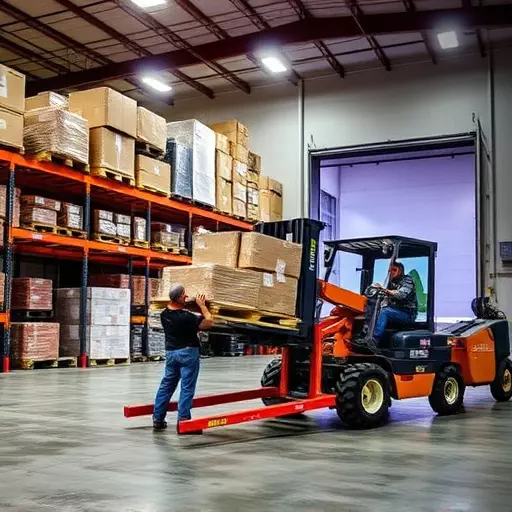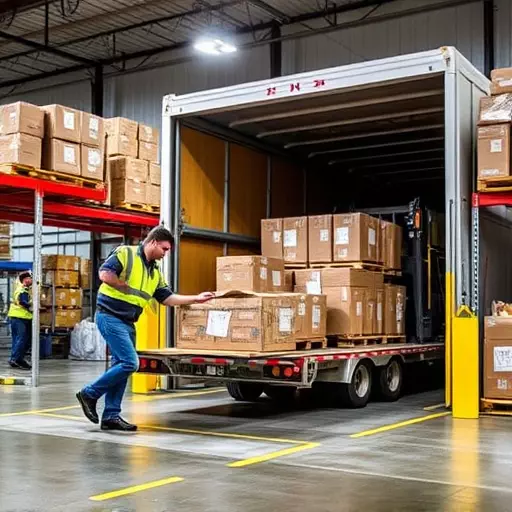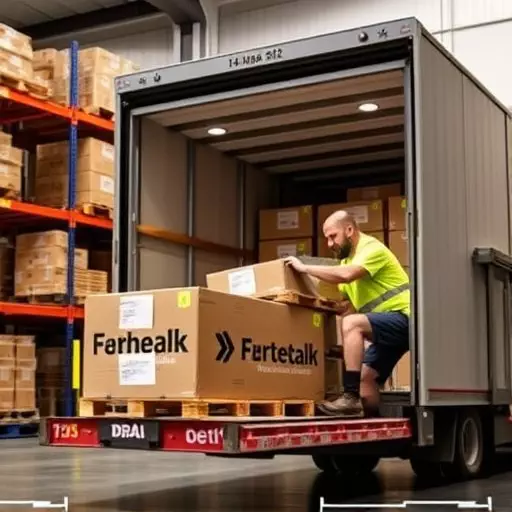Loading dock levelers are vital for modern warehouse management in Holland, Ohio, optimizing loading and unloading processes. These devices enhance productivity, minimize merchandise damage, and improve safety by ensuring proper alignment between trailers/trucks and warehouse floors. Implementing best practices like high-quality levelers and standardized unloading protocols streamlines operations, boosts customer satisfaction, and fosters safer work environments. Effective adherence to safety protocols, including equipment inspection, proper positioning, tie-down techniques, PPE usage, clear communication, and awareness of hazards, is crucial for preventing accidents and injuries during critical warehouse operations.
“Loading dock levelers are indispensable tools for efficient warehouse management, especially in dynamic logistics hubs like Holland, Ohio. This article delves into the crucial role of these devices in streamlining operations at warehouses and distribution centers. We explore best practices for optimizing loading and unloading processes, ensuring worker safety, and addressing common hazards encountered in Holland’s thriving logistics sector. Additionally, we discuss advanced technologies revolutionizing warehouse efficiency.”
- Understanding Loading Dock Levelers: Essential Equipment for Efficient Warehouse Operations
- The Role of Loading and Unloading Services in Holland, Ohio’s Logistics Sector
- Optimizing Warehouse Loading Techniques: Best Practices for Streamlined Processes
- Ensuring Safe Unloading Practices: Step-by-Step Guidelines for Warehouse Workers
- Common Safety Hazards During Loading/Unloading and How to Mitigate Them
- Advanced Technologies Enhancing Loading Dock Operations in Modern Warehouses
Understanding Loading Dock Levelers: Essential Equipment for Efficient Warehouse Operations

Loading dock levelers are indispensable pieces of equipment in modern warehouse management. They serve as a bridge between trucks and warehouses, facilitating efficient loading and unloading processes. By ensuring a smooth transition of goods, these levelers enhance productivity, minimize damage to merchandise, and improve overall safety at docks. In the competitive landscape of logistics, adopting advanced warehouse loading techniques like the use of dock levelers can significantly boost operations for businesses in Holland, Ohio.
When it comes to unloading safety protocols, loading dock levelers play a pivotal role. They ensure that trailers and trucks are properly aligned with the warehouse floor, preventing sudden movements or shifts during the unloading process. This reduces the risk of accidents and injuries, especially in bustling warehouses where the constant flow of goods necessitates robust safety measures. Implementing the right loading and unloading services can streamline operations, enhance customer satisfaction, and contribute to a safer work environment for employees handling these critical tasks.
The Role of Loading and Unloading Services in Holland, Ohio’s Logistics Sector

The bustling logistics sector in Holland, Ohio, relies heavily on efficient loading and unloading services to facilitate smooth operations. These services play a pivotal role in ensuring that goods are securely loaded onto trucks or transported through various modes, maintaining the integrity of the cargo during transit. With a focus on optimizing warehouse loading techniques, Holland’s businesses employ advanced technologies and innovative methods to streamline the process. This includes utilizing specialized equipment like loading dock levelers, which bridge the gap between the warehouse floor and the vehicle, ensuring seamless and safe loading/unloading operations.
Safety is paramount in the unloading phase, especially considering the volume and variety of goods handled. Unloading safety protocols are rigorously followed to mitigate risks associated with heavy machinery, fragile items, and potential hazards within the warehouse environment. By adhering to these protocols, Holland’s logistics industry maintains a high standard of safety, ensuring the well-being of workers and the integrity of the merchandise.
Optimizing Warehouse Loading Techniques: Best Practices for Streamlined Processes

Optimizing warehouse loading and unloading processes is a key aspect of efficient logistics management. By implementing best practices for warehouse loading techniques, businesses in Holland, Ohio, can enhance their operations and improve overall productivity. One of the primary goals is to streamline the flow of goods, ensuring that loading and unloading services are conducted safely and effectively. This involves strategic planning and the adoption of modern technologies.
For instance, investing in high-quality, reliable loading dock levelers can significantly reduce the risk of workplace accidents during unloading. These devices create a seamless transition between the truck bed and the warehouse floor, facilitating faster and safer loading and unloading of materials. Additionally, implementing standardized safety protocols for all unloading procedures is essential to protect workers from potential hazards, such as falling objects or uneven surfaces. Regular training sessions and clear communication among staff can contribute to a culture of safety, ensuring that best practices are consistently followed.
Ensuring Safe Unloading Practices: Step-by-Step Guidelines for Warehouse Workers

Ensuring safe unloading practices is paramount for warehouse workers to prevent accidents and injuries. When handling goods using loading dock levelers in Holland, Ohio, following step-by-step guidelines is crucial. First, inspect the dock leveler for any signs of damage or wear before use. Ensure proper positioning and leveling of the equipment to avoid uneven surfaces that could cause slips or falls.
Next, secure the load properly using appropriate tie-down techniques to prevent shifting during unloading. Workers should always wear appropriate personal protective equipment (PPE), including sturdy shoes, gloves, and eye protection. Maintain clear communication with the driver to ensure smooth coordination during the unloading process. Additionally, be mindful of potential hazards like narrow aisles or overhead obstacles to avoid collisions.
Common Safety Hazards During Loading/Unloading and How to Mitigate Them

Loading and unloading processes in warehouses can present several safety hazards that require careful attention to prevent accidents and injuries. Common risks include slip-and-fall incidents due to loose or wet surfaces, falling objects from heights, and issues related to heavy machinery. To mitigate these dangers, implementing robust safety protocols is essential.
One effective strategy is ensuring proper training for all staff involved in loading/unloading operations. This includes teaching them the correct use of equipment like dollies, pallets, and loading dock levelers to maintain stability and prevent tipping. Additionally, maintaining clear communication during the process can help avoid collisions. Regular inspections of warehouse floors, promptly addressing any slippery or uneven surfaces, and securing loose items or packaging are crucial steps in creating a safer environment. Unloading safety protocols should also involve wearing appropriate personal protective equipment (PPE), such as high-visibility vests and sturdy footwear, to maximize worker safety during these critical operations.
Advanced Technologies Enhancing Loading Dock Operations in Modern Warehouses

In today’s fast-paced e-commerce landscape, efficient loading and unloading processes are vital for successful warehouse operations. Advanced technologies are revolutionizing how warehouses manage these tasks, enhancing speed, safety, and overall productivity. For instance, automated loading dock levelers in Holland, Ohio, have become game-changers in the industry. These innovative devices ensure seamless transitions between trucks and docks, streamlining the loading/unloading process, and reducing manual labor requirements.
By implementing advanced loading techniques, warehouses can significantly improve their unloading safety protocols. Automated systems feature precise leveling mechanisms, minimizing the risk of accidents or injuries associated with traditional hand-operated levelers. Moreover, they offer real-time data on weight distribution and load stability, enabling warehouse managers to make informed decisions for optimized cargo handling. This not only enhances operational efficiency but also contributes to a safer work environment.


